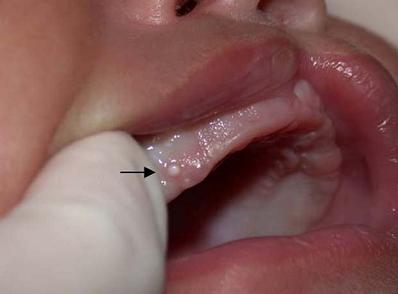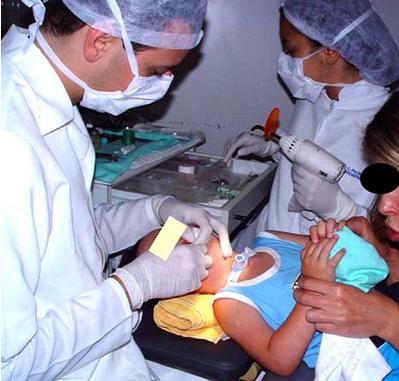Dental Aspects in the Management of Infants with Cleft Lip and Palate
Children with cleft lip and palate present peculiar dental characteristics since birth. Ideally, any child should have the first contact with the dental professional during the first year of life. This approach has revealed beneficial effects on the oral health of children, especially concerning the prevention of dental caries. However, for this specific population group, the main concern of families during early childhood is the accomplishment of primary repair surgeries, which follows specific protocols at each cleft center. Usually, lip repair is performed at 3 to 6 months of age, and palate repair is accomplished at the age of 1 year.
As described, there are several types of clefts that affect different structures, consequently causing different extents of dental disorders. This section of the chapter describes the main aspects of infants with cleft lip and palate and the dental management at this stage.
Breastfeeding
This aspect raises several doubts when dealing with infants with clefts. The mothers and even the health professionals do not believe that the child may be breastfed, as evidenced by studies demonstrating that a low percentage of children with clefts receive breastfeeding. However, breastfeeding should always be encouraged and may be possible depending on the effort and motivation of the mother, who should receive adequate counseling.
For infants with isolated cleft lip, the greatest challenge for breastfeeding is the grasping and sealing of the nipple for suction. In this case, the mother may be guided to promote the sealing herself with the breast. With regard to cleft lip and palate and isolated cleft palate, the infant is unable to establish the necessary intraoral negative pressure when positioning the tongue between the nipple and the palate, due to the presence of the palatal cleft. In these cases, the possibility of breastfeeding will depend on the mother motivation for the attempts and the infant adaptation to this situation. Despite these difficulties, breastfeeding should always be attempted and encouraged by the health professionals involved in the care to newborns, because it involves important emotional and physiological aspects for both the mother and the infant.
If breastfeeding is impossible, the infant must be fed using a baby bottle. Rubber bottle nipples should be used, because silicone nipples are more rigid and may cause ulcerative lesions on the nasal septum exposed by the cleft palate.
The nipple should have orthodontic shape and a 0.8- to 1-mm orifice to allow the milk to flow in drops. This way, the infant will have to suck strongly and will exercise the orofacial musculature. Other options for infant feeding that avoid the contact with the bottle nipple are the use of disposable plastic glasses and spoons. In both cases, the infant should be fed offering small quantities.
In any case, the infant should be always kept half-seated during feeding to reduce the risk of choking and milk reflux to the auditory tube, which at this age presents horizontal positioning aligned with the soft palate. The auditory tube dysfunction and the communication between the oral and nasal cavities caused by the cleft predispose these infants to higher risk of recurrent ear infections, which may damage the hearing function in the.
Another important aspect from a dental standpoint concerns the utilization of the baby bottle and the early introduction of sugar in the diet, which may favor and increase the occurrence of caries. Ideally, if a baby bottle is used to feed the infant, sugar should not be added to the formula or milk to delay the first contact with sugar. This represents a healthy dietary habit from a nutritional standpoint and is also beneficial for the prevention of caries.
Common Oral Characteristics in Early Childhood
The most common tooth abnormalities in infants with clefts involve the tooth eruption and are related with the extent of the defect. The natal or neonatal teeth are the most prevalent at this age range, affecting 2% of children with unilateral cleft lip and palate and 11% of children with bilateral cleft lip and palate. These teeth are usually located at the cleft area and most present mobility due to the poor bone implantation, since in general no root formation occurs. These teeth should be extracted dueto the high risk of aspiration of these teeth, considering the communication between the oral and nasal cavities in the presence of an unrepaired cleft.
The gingival cysts of the newborn are also commonly observed in children with cleft lip and palate, similarly to infants without clefts. They present a nodular aspect with yellow-whitish color and may occur on the alveolar ridge, mucosa, or on the palate. No specific treatment is required for these cysts rather than follow-up until spontaneous regression of the lesion.
Preventive Treatment
Before tooth eruption, the preventive treatment comprises cleaning of the oral cavity with gauze, a cloth or cotton swabs moistened with saline or filtered water. The hygiene should be performed on all regions of the mouth, including the alveolar ridges, oral mucosa, inner part of the cleft and the tongue. The parents should be instructed to examine the child’s mouth frequently and search for professional advice if any abnormality is observed. After eruption of the first tooth, the preventive procedure should be performed using a toothbrush or performing professional prophylaxis, always reinforcing the utilization of fluoride dentifrice only after 1 year of age and in a quantity corresponding to 1/4 of a rice seed. The toothbrush should have extra soft bristles, small and rounded head and a good handle to be used by an adult. If the child presents teeth with enamel hypoplasia, which is very common in patients with cleft lip and palate, these teeth should receive application of fluoride varnish or even preventive restorations by filling the defect with glass ionomer cement.
Restorative Treatment
When the infant requires restorative treatment, it is usually performed under physical restraint, with the help and consent from the parents or caretakers. Negative behavior is expected after 1 year of age, and the child commonly cries to relieve the stresses related to the environment, procedures and the physical restraint itself. The restraint is necessary to protect the child.
Extraction of Natal/Neonatal Teeth
As previously described, when the infant presents this alteration, extraction of these teeth is indicated in most cases because the tooth usually presents mobility and poses the risk of aspiration. The procedure is performed only with application of topical anesthesia after careful drying of the mucosa, since the tooth does not present bone implantation. The extraction may be performed with a spatula n. 7 and hemostasis is achieved by compressing the site with sterile gauze, without need of suture.












This article is very nice nad informative
ReplyDeleteThis comment has been removed by the author.
ReplyDelete